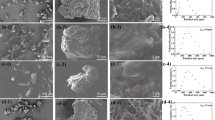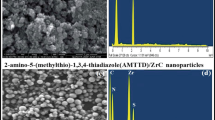Abstract
Marine structures are prone to biocorrosion, so developing a suitable coating system to combat corrosion is essential. The present work is focused on the development of a multilayered epoxy-based nanocomposite (NC) coating system reinforced with ZnO filler in the first layer coat (NC1), ZnO and Cu2O in the second layer (NC2), and the third layer consisting of a varying percentage of TiO2 with 5 wt%, 10 wt%, and 15 wt% of TiO2 designated as NC3, NC4, and NC5, respectively, as top coat on the bare steel. Brush coating was employed to fabricate the coatings. Surface morphology and mechanical properties, wettability, corrosion, and biocorrosion behavior of the bare steel and coated substrates were examined. Mechanical properties such as linear scratch hardness and posi adhesion test values of the coatings were found to be in the order NC1 < NC2 < NC3 < NC4 < NC5. The NC3-coating system comprising three layers of coating reinforced with 5 wt% TiO2 imparting hydrophobicity offered maximum resistance to microbial adhesion with 93% and 91% reduction in corrosion rate than the bare metal in natural and artificial seawater, respectively, after the 7th day of immersion. The bacterial and fungal cell counts in the biofilm after the 7th day of immersion were reduced by four and three orders of magnitude, respectively, in the nanocomposite against the bare substrate providing good biofouling resistance. NC3 coating also prevented the release of metal ions into the seawater and acted as a barrier for the leaching of metals from the coating underneath, thus, proving to be safe for the marine environment.








Similar content being viewed by others
Data Availability
The datasets generated during and/or analyzed during the current study are available from the corresponding author on reasonable request.
References
Safavi MS, Fathi M, Charkhesht V, Jafarpour M, Ahadzadeh I (2020) Electrodeposition of Co–P coatings reinforced by MoS2 + Y2O3 hybrid ceramic nanoparticles for corrosion-resistant applications: influences of operational parameters. Metall Mater Trans A Phys Metall Mater Sci 51(12):6740–6758. https://doi.org/10.1007/s11661-020-05987-8
Yebra DM, Kiil S, Dam-Johansen K (2004) Antifouling technology—past, present and future steps towards efficient and environmentally friendly antifouling coatings. Prog Org Coat. https://doi.org/10.1016/j.porgcoat.2003.06.001
Abubakar A, Mustafa MB, Johari WLW, Zulkifli SZ, Yusuff FBM (2016) Tributyltin (TBT) tolerance of indigenous and non-indigenous bacterial species. Water Air Soil Pollut. https://doi.org/10.1007/s11270-016-2946-4
Chambers LD, Stokes KR, Walsh FC, Wood RJK (2006) Modern approaches to marine antifouling coatings. Surf Coat Technol 201(6):3642–3652. https://doi.org/10.1016/j.surfcoat.2006.08.129
Fotovvati B, Namdari N, Dehghanghadikolaei A (2019) On coating techniques for surface protection: a review. J Manuf Mater Process. https://doi.org/10.3390/jmmp3010028
Ren Y et al (2021) A review on tribology of polymer composite coatings. Friction. https://doi.org/10.1007/s40544-020-0446-4
Yi G, Riduan N, Yuan Y (2019) Microbicide surface nano-structures. Crit Rev Biotechnol 39(7):964–979
Fathi M, Safavi MS, Mirzazadeh S, Ansariyan A, Ahadzadeh I (2020) A promising horizon in mechanical and corrosion properties improvement of Ni–Mo coatings through incorporation of Y2O3 nanoparticles. Metall Mater Trans A Phys Metall Mater Sci 51(2):897–908. https://doi.org/10.1007/s11661-019-05559-5
Dalili N, Edrisy A, Carriveau R (2009) A review of surface engineering issues critical to wind turbine performance. Renew Sustain Energy Rev 13(2):428–438. https://doi.org/10.1016/j.rser.2007.11.009
Safavi MS, Rasooli A, Sorkhabi FA (2020) Electrodeposition of Ni–P/Ni–Co–Al2O3 duplex nanocomposite coatings: towards improved mechanical and corrosion properties. Trans Inst Met Finish 98(6):1–9. https://doi.org/10.1080/00202967.2020.1802106
Xu G, Pranantyo D, Xu L, Neoh KG, Kang ET, Teo SLM (2016) Antifouling, antimicrobial, and antibiocorrosion multilayer coatings assembled by layer-by-layer deposition involving host–guest interaction. Ind Eng Chem Res 55(41):10906–10915. https://doi.org/10.1021/acs.iecr.6b02190
Khadem M, Penkov OV, Yang HK, Kim DE (2017) Tribology of multilayer coatings for wear reduction: a review. Friction 5(3):248–262. https://doi.org/10.1007/s40544-017-0181-7
Alhumade H, Yu A, Elkamel A, Simon L, Abdala A (2016) Enhanced protective properties and UV stability of epoxy/graphene nanocomposite coating on stainless steel. Express Polym Lett 10(12):1034–1046. https://doi.org/10.3144/expresspolymlett.2016.96
CaderMhdHaniffa MA, Ching YC, Abdullah LC, Poh SC, Chuah CH (2016) Review of bionanocomposite coating films and their applications. Polymers (Basel) 8(7):1–33. https://doi.org/10.3390/polym8070246
Sørensen PA, Kiil S, Dam-Johansen K, Weinell CE (2009) Anticorrosive coatings: a review. J Coatings Technol Res 6(2):135–176. https://doi.org/10.1007/s11998-008-9144-2
Fathi M et al (2021) Co–P alloy matrix composite deposits reinforced by nano-MoS2 solid lubricant: an alternative tribological coating to hard chromium coatings. Tribol Int 159:106956. https://doi.org/10.1016/j.triboint.2021.106956
Tamayo L, Azócar M, Kogan M, Riveros A, Páez M (2016) Copper-polymer nanocomposites: an excellent and cost-effective biocide for use on antibacterial surfaces. Mater Sci Eng C 69:1391–1409. https://doi.org/10.1016/j.msec.2016.08.041
Rodríguez-Llamazares S, Mondaca MA, Badilla C, Maldonado A (2012) PVC/copper oxide composites and their effect on bacterial adherence. J Chil Chem Soc. https://doi.org/10.4067/S0717-97072012000200022
Rasooli A, Safavi MS, Ahmadiyeh S, Jalali A (2020) Evaluation of TiO2 nanoparticles concentration and applied current density role in determination of microstructural, mechanical, and corrosion properties of Ni–Co alloy coatings. Prot Met Phys Chem Surf 56(2):320–327. https://doi.org/10.1134/S2070205120020215
Shen GX, Chen YC, Lin L, Lin CJ, Scantlebury D (2005) Study on a hydrophobic nano-TiO2 coating and its properties for corrosion protection of metals. Electrochim Acta 50(25–26):5083–5089. https://doi.org/10.1016/j.electacta.2005.04.048
Zhang X et al (2016) Corrosion behavior of Zn-incorporated antibacterial TiO2 porous coating on titanium. Ceram Int 42(15):17095–17100. https://doi.org/10.1016/j.ceramint.2016.07.220
Buhl KB, Agergaard AH, Lillethorup M, Nikolajsen JP, Pedersen SU, Daasbjerg K (2020) Polymer brush coating and adhesion technology at scale. Polymers (Basel) 12(7):1–15. https://doi.org/10.3390/polym12071475
Videla HA (1994) Biofilms and corrosion interactions on stainless steel in seawater. Int Biodeterior Biodegrad 34(3–4):245–257. https://doi.org/10.1016/0964-8305(94)90086-8
Morris AJ, Byrne TC, Madden JF, BarthReller L (1996) Duration of incubation of fungal cultures. J Clin Microbiol 34(6):1583–1585. https://doi.org/10.1128/jcm.34.6.1583-1585.1996
Li Y, Luo B, Guet C, Narasimalu S, Dong Z (2019) Preparation and formula analysis of anti-biofouling titania-polyurea spray coating with nano/micro-structure. Coatings. https://doi.org/10.3390/coatings9090560
Madhup MK, Shah NK, Parekh NR (2017) The effect of zinc oxide nanoparticles on cohesive and adhesive bond of epoxy/amine coating on carbon steel substrate. IOSR J Appl Chem 10(7):47–58. https://doi.org/10.9790/5736-1007024758
Ghosal A, Ahmad S (2017) High performance anti-corrosive epoxy-titania hybrid nanocomposite coatings. New J Chem 41(11):4599–4610. https://doi.org/10.1039/c6nj03906e
Sahoo BN, Kandasubramanian B, Thomas A (2013) Effect of TiO2 powder on the surface morphology of micro/nanoporous structured hydrophobic fluoropolymer based composite material. J Polym 2013:1–4. https://doi.org/10.1155/2013/615045
Little BJ, Lee JS (2015) Microbiologically influenced corrosion. In: Oil and gas pipelines: integrity and safety handbook. Wiley, New York, pp 387–398. https://doi.org/10.1002/9781119019213.ch27
Eberl HJ, Sudarsan R (2008) Exposure of biofilms to slow flow fields: the convective contribution to growth and disinfection. J Theor Biol 253:788–807. https://doi.org/10.1016/j.jtbi.2008.04.013
Dunsmore BC, Jacobsen A, Hall-Stoodley L, Bass CJ, Lappin-Scott HM, Stoodley P (2002) The influence of fluid shear on the structure and material properties of sulphate-reducing bacterial biofilms. J Ind Microbiol Biotechnol 29(6):347–353. https://doi.org/10.1038/sj.jim.7000302
Marmur A (2006) Super-hydrophobicity fundamentals: implications to biofouling prevention. Biofouling. https://doi.org/10.1080/08927010600562328
Jagtap RN, Patil PP, Hassan SZ (2008) Effect of zinc oxide in combating corrosion in zinc-rich primer. Prog Org Coat 63(4):389–394. https://doi.org/10.1016/j.porgcoat.2008.06.012
Oparaodu KO, Okpokwasili GC (2014) Comparison of percentage weight loss and corrosion rate trends in different metal coupons from two soil environments. Int J Environ Bioremed Biodegrad 2(5):243–249
Jagtap RN, Patil PP, Hassan SZ (2008) Effect of zinc oxide in combating corrosion in zinc-rich primer. Prog Org Coatings 63(4):389–394. https://doi.org/10.1016/j.porgcoat.2008.06.012
Monds RD, O’Toole GA (2009) The developmental model of microbial biofilms: ten years of a paradigm up for review. Trends Microbiol. https://doi.org/10.1016/j.tim.2008.11.001
Muthulakshmi L, Rajini N, Nellaiah H, Kathiresan T, Anand Kumar B, VaradaRajalu A (2018) Development of polymer nanocomposites using cellulose/silver for antifouling applications: a preliminary investigations of silver-coated cellulose composite film for antifouling applications. Elsevier, Amsterdam. https://doi.org/10.1016/B978-0-08-102262-7.00014-3
Flemming HC, Wingender J (2001) Relevance of microbial extracellular polymeric substances (EPSs)—part I: structural and ecological aspects. Water Sci Technol 43(6):1–8. https://doi.org/10.2166/wst.2001.0326
Zhang X et al (2018) Effects of copper nanoparticles in porous TiO2 coatings on bacterial resistance and cytocompatibility of osteoblasts and endothelial cells. Mater Sci Eng C 82:110–120. https://doi.org/10.1016/j.msec.2017.08.061
Morán G, Méallet-Renault R (2018) Superhydrophobic surfaces toward prevention of biofilm-associated infections. In: Bacterial pathogenesis and antibacterial control. InTechOpen, London. https://doi.org/10.5772/intechopen.72038.
Selim MS, Yang H, Wang FQ, Fatthallah NA, Huang Y, Kuga S (2019) Silicone/ZnO nanorod composite coating as a marine antifouling surface. Appl Surf Sci. https://doi.org/10.1016/j.apsusc.2018.10.004
Azizi-Lalabadi M, Ehsani A, Divband B, Alizadeh-Sani M (2019) Antimicrobial activity of titanium dioxide and zinc oxide nanoparticles supported in 4A zeolite and evaluation the morphological characteristic. Sci Rep. https://doi.org/10.1038/s41598-019-54025-0
Kubacka A et al (2014) Understanding the antimicrobial mechanism of TiO2-based nanocomposite films in a pathogenic bacterium. Sci Rep. https://doi.org/10.1038/srep04134
Adeleye AS, Oranu EA, Tao M, Keller AA (2016) Release and detection of nanosized copper from a commercial antifouling paint. Water Res 102:374–382. https://doi.org/10.1016/j.watres.2016.06.056
Janczarek M, Endo M, Zhang D, Wang K, Kowalska E (2018) Enhanced photocatalytic and antimicrobial performance of cuprous oxide/titania: the effect of titania matrix. Materials (Basel). https://doi.org/10.3390/ma11112069
Wang G, Weng D, Chen C, Chen L, Wang J (2020) Influence of TiO2 nanostructure size and surface modification on surface wettability and bacterial adhesion. Colloids Interface Sci Commun 34:100220. https://doi.org/10.1016/j.colcom.2019.100220
Kamei G (2018) Effects of nano-particles titanium dioxide (TiO2) on bio-fouling in estuarine environment. Indian J Geo-Marine Sci 47(5):1047–1049
Funding
No funding from any organization. The research work is outcome of master research project of Preethi Shetty.
Author information
Authors and Affiliations
Contributions
PS: experimental work, design of work, manuscript preparations, SBA: design of work, technical discussion, manuscript preparations, and revisions. VSK: Design of work, technical discussion, manuscript preparations, and revisions.
Corresponding author
Ethics declarations
Conflict of interest
The authors declare that they have no conflict of interest. Compliance with ethical standards.
Additional information
Publisher's Note
Springer Nature remains neutral with regard to jurisdictional claims in published maps and institutional affiliations.
Rights and permissions
Springer Nature or its licensor (e.g. a society or other partner) holds exclusive rights to this article under a publishing agreement with the author(s) or other rightsholder(s); author self-archiving of the accepted manuscript version of this article is solely governed by the terms of such publishing agreement and applicable law.
About this article
Cite this article
Shetty, P., Arya, S.B. & Kodialbail, V.S. Biocorrosion Behavior of Epoxy-Based Multilayer Nanocomposite Coatings. J Bio Tribo Corros 9, 45 (2023). https://doi.org/10.1007/s40735-023-00763-8
Received:
Revised:
Accepted:
Published:
DOI: https://doi.org/10.1007/s40735-023-00763-8




